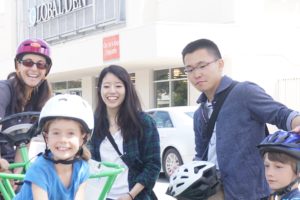Alison Paulin is an Aucklander and long-time member of Bike Auckland/ Cycle Action Auckland. She shares her experience over the last few years promoting two-wheeled transport technology in the heart of the global HQ for information technology – sparking some interesting comparisons with how we do things here…

I’ve been living in San Jose, California for three years now, and began working for the Silicon Valley Bicycle Coalition (SVBC) soon after I moved here. I went along to volunteer – and ended up with a part-time paid job managing their valet bicycle parking services.
Silicon Valley refers to the valley that (when it has water in it) flows into the San Francisco Harbour, south-east of San Fran. It used to be filled with orchards, but is now one of the richest areas in the US, thanks to the tech boom of the last couple of decades that was centred here. It’s also home to a fairly large homeless population and many families struggling to make ends meet (due mainly to the housing crisis and lack of tenant protection). 1.862 million people live in Santa Clara county (which includes San Jose and nearby ‘cities’ such as Cupertino and Palo Alto), and 747,373 in San Mateo County (which includes Redwood City, Menlo Park and as far north as San Francisco Airport).
The weather in this region is perfect for biking, usually fine and warm, with relatively little wind or rain. The land is flat, though the valley has hills to every side except the northwest, where the upper reaches of the San Francisco harbour join Santa Clara City.
The Silicon Valley Bicycle Coalition, based in San Jose, covers two counties (with 2.7 million people and many ‘cities’). We’re the poor cousin to the thriving San Francisco Bicycle Coalition which has hundreds of thousands of members. But we’re certainly not small by New Zealand standards. We have nine full-time staff, and they work on three different areas: Advocacy, Membership and Development, and Education.
So how does SVBC find the funds to employ nine staff? Well, ten years ago, they employed their first paid staff member, an Executive Director, who worked out of her garage. She worked on getting contracts and sponsorships for large events: ‘Bike to Work Day’ was one of the first of these events.
Gradually, revenue streams built up, with the help of some of the big tech companies who support the SVBC through sponsorship, and also sometimes spearhead bike initiatives for their own staff. Ever heard of the Google bikes, for example? These bikes can be borrowed and left anywhere on their large campus. In partnership with SVBC, Google also offers matching grants for cities in the valley to come up with ways to be bike-friendlier. [Ed note: hmmm… an exciting model for Auckland-based companies looking to kickstart bike infrastructure in their neighbourhoods to make it easier for locals to bike to work?]

Contracts are an important part of the SVBC business model. Cycle safety workshops are time consuming, but two staff manage these, mainly focused on school children, and their salaries are paid by the fees charged for the workshops. SVBC helps schools and other organisations to apply for grants to cover the costs of the workshops. The grants mainly come from City Councils, who support any initiative that works towards the goal of increased active transport and fewer private vehicles on the roads.
Bike parking is another revenue stream for SVBC. Event organizers pay for the Bicycle Coalition to provide bike racks and staff (including a team of volunteers that I recruit and train) to run a bike corral with valet bicycle parking services. It’s like any other kind of valet parking: event attendees hand over their bikes and get a ticket stub for retrieving it when they are ready to go home.

Bike to Work Day is just around the corner, so I’ve been brought on for a few more hours per week to help out. I’m currently working on ‘Bike to Shop Day’ (with an unfortunate acronym that sounds like PTSD). I’m working with the management of a large mall which seems hugely unfriendly to bicycles (ringing any bells, Aucklanders?!) to coordinate a really big event: we’re organizing ‘bike pool’ rides to be led by trained ride leaders, plus valet bicycle parking and free shopping delivery for those who ride their bicycle to the shops on the day.
Last year we borrowed one of Google’s conference bikes to get the word out in the lead up to the event…

Many of the issues that face bicyclists and advocacy organisations here in the Bay Area are the same as those we experience in New Zealand, especially in the big cities. Car drivers with reckless disregard for bicyclists and their safety always top the list of complaints; but in my experience, California drivers are much more considerate than Auckland drivers! (I suspect it is one of the few benefits of the right to sue which is so strongly upheld in the USA.)
One of the biggest challenges for Silicon Valley is the freeway system, designed to get as many cars moving as quickly as possible. Once a freeway has been built, it’s incredibly expensive to get tunnels or bridges retrofitted for bike access, so just to get across many of the motorways around where we live takes a significant amount of back-tracking. [Ed: that bit sounds awfully familiar…]
Within that local context, we’re working to adjust the balance. Our central goal is to see 10% of trips taken by bike by 2025 in our area, and our vision is to make bikes a major mode choice for travel in Silicon Valley (you can check out the Silicon Valley Bike Vision here).
My greetings to all the cycling advocates in New Zealand. I enjoy hearing about your work, and hope to rejoin you soon.
—Alison Paulin, Bike Parking Manager, Silicon Valley Bicycle Coalition





